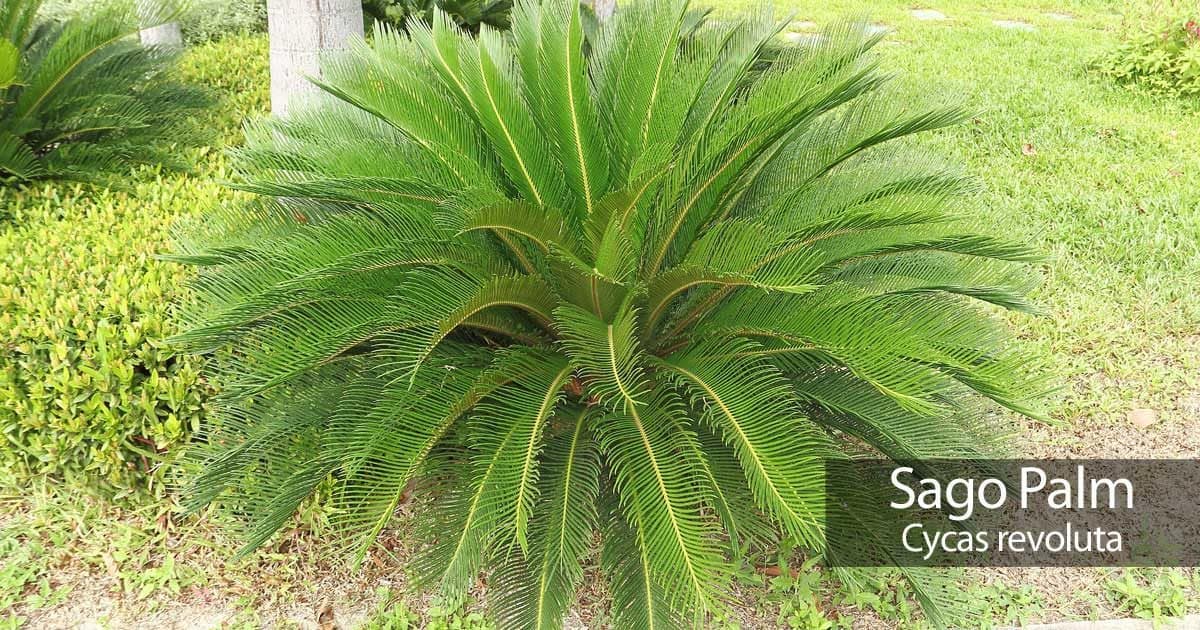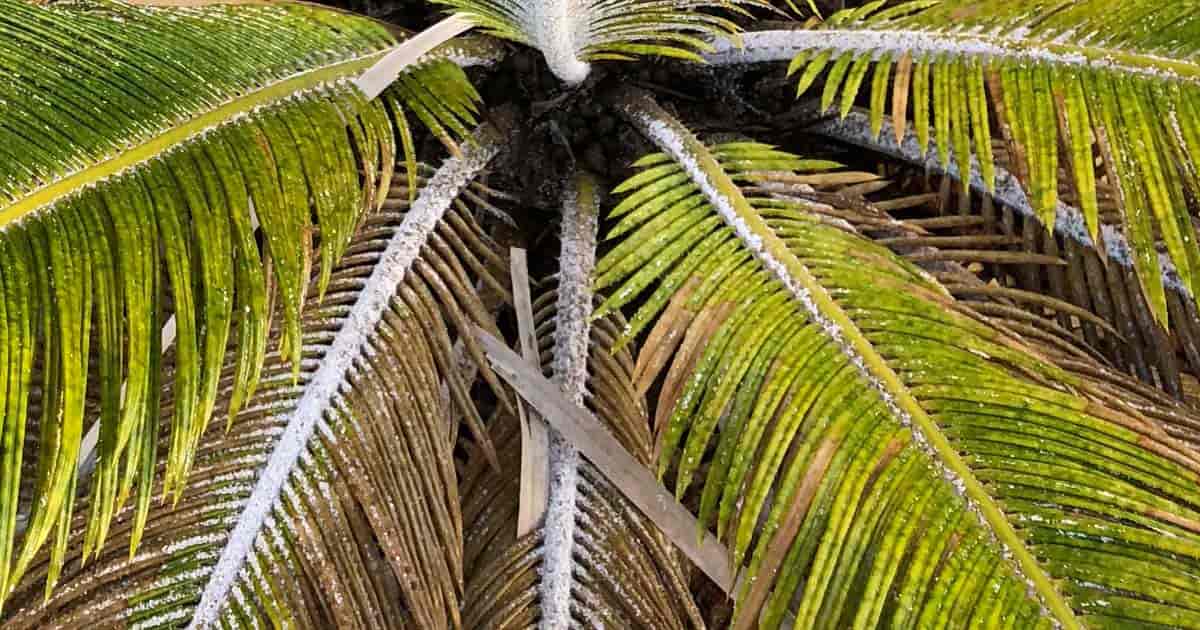Are your Sago Palm leaves turning yellow? If so, you are not alone!
You might be asking, why is my sago palm turning yellow?
First, understand that the Sago palm tree (Cycas revoluta) is not a true palm tree at all.

In fact, it is a relative of the pine tree that has been around since prehistoric times.
These hardy, slow-growing Asian trees look quite tropical but can survive temperatures down to 15° degrees Fahrenheit.
Hardy though they are, Sago plants can fall prey to a number of different problems, and all of these may manifest as yellowing leaves.
In this article, we will share information to help you figure out what is plaguing your plant and what you can do to fix your sago palm turning yellow.
Here are the various sago palm problems that may cause your plant to turn yellow.
#1 – Sago Palm Yellowing From Insect Infestation aka Plant Scale
Scale insects may attack and slowly turn the sago leaves yellow. The Asian scale is one of the most common sago palm pests often found in Florida.
We can usually find these types of pests on the undersides of sago palm fronds, where they attach themselves and suck the sap.

When you find cycad scale, remove the infested leaves and destroy them. Don’t toss them into your compost heap.
Other pests that may cause yellow leaves include mealybugs, aphids, and spider mites.
Treat Sago with a horticultural oil or neem oil spray to prevent further infestation. You may also use insecticidal soap on the leaves. However, it is best to simply prevent introducing scale insects to your collection.
As a part of your Sago palm care, inspect any plant you’re considering buying for pests before you bring it home, and regularly scout for pests.
NOTE: There has been some success controlling the Asian scale using coffee. Our PlantCareToday article looks at the Sago Palm scale and the Asian scale.

Revoluta leaves covered with Asian cycad scale bugs
#2 – Soil Nutrient Deficiencies Equals Leaves Turning Yellow
Yellow Sago palm fronds can show up when plants are lacking in manganese or magnesium. Feed your Sago cycas with a slow-release fertilizer high in magnesium and potassium.
If the color change manifests in streaks and spots, a manganese deficiency is suspected.
Moreover, if your plant’s central leaf margin remains green, but the bands turn yellow, it’s likely due to magnesium deficiency.
Chelated manganese applied in a foliar application can help remedy this problem, as can manganese sulfate applied as a soil drench.
In addition, sago palm yellow tips or fronds indicate nitrogen deficiency or chlorosis.
If it’s potassium deficiency, the older fronds with the midrib turn yellow.
Be sure that any fertilizer applied contains trace minerals and chelated iron for plants to help keep the leaves green.
As your plant begins to display green, new growth cuts back to the older yellow leaves.
#3 – Too Much Fertilizer
Excessive fertilizing can cause Sago fronds to turn yellow.
Be sure to read the manufacturer’s instructions carefully and follow them.
Excessive fertilizing can lead to the buildup of mineral salts.

When the plant uptakes too many minerals, it can burn both the leaves and the plant tissues.
When this happens, the edges of the leaf become discolored, turn brown, and curl first, and then the damage moves toward the mid-rib of the leaf.
Related: Tips on Picking A Sago Palm Fertilizer
#4 – Sago Palm Sunburn
Too much direct sunlight can burn or bleach the leaves. It’s possible to grow Sagos in full sun, but you must give sagos plenty of time to acclimate.
It’s really best to locate your Sago in an area with bright light and partial shade. In this sort of setting, you will get larger leaves with better color.

Remember that partial shade will give your plant greener foliage over time.
Be sure to keep newly propagated plants and seedlings protected in a cooler, filtered shade or low-light setting.
#5 – Freezing
Even though revoluta cycads can survive extreme cold, they may still suffer the ill effects of cold damage and light frosts.
Cold weather or frostbite can cause cycad leaves turning yellow.
This happens because the roots cannot uptake nutrients from the soil well in cold weather.
When this happens, you have to wait for warmer weather.
Leaves may even freeze and turn yellow or brown.

If this happens, leave the dead leaves in place until the weather turns warm, then cut all the leaves off back to the trunk.
New leaves should soon take their place.
#6 – Over Or Underwatering
Both underwatering and overwatering can cause Cycas revoluta yellow leaves.
When you water too much, you risk root rot, which can result in nutrient deficiency. Poor soil drainage can also cause root issues, leading to yellowing. Always use a pot with drainage holes and soil with good drainage.
When planting in containers, use well-drained soil. Keep it moist, but don’t allow the plant to stand in water.
Remember that sago palms may also turn yellow due to moisture stress, so it’s best to water your plant once every 1 to 2 weeks instead.
When watering the Sago palms, water completely and allow the potting soil to dry completely before you water again. Typically, you should water your Sago palm plant about once a week.
#7 – Disturbances
Transplant shock can cause leaves to turn yellow. If you disturb the root ball by digging and moving the plant abruptly from one setting to another, expect the leaves to turn yellow and even fall off.
After adjusting to its new home and roots become established, the plant should put out green leaves.

Once you have your Sago palm in place, it’s best to leave it there as these are similar to ficus trees in that they will lose their leaves if you move them around too much.
When Sagos are moved from one place to another, the leaves may be bruised.
When you purchase a Sago and bring it home, it may take some time for this slow grower to adjust, and it may already have bruised leaves, which will manifest as fading leaves.
Locate your Sago in an area where it won’t encounter a lot of foot traffic with animals or people brushing up against the limbs.
Summary
The Cycas (Sago) are popular gardening landscape plants in southern California and Florida. You can find them in most garden centers.

They are slow, healthy growers. When you encounter your palm tree leaves starting to turn yellow, it will take some time to recover.
Be patient! These wonderful plants are worth the effort.
